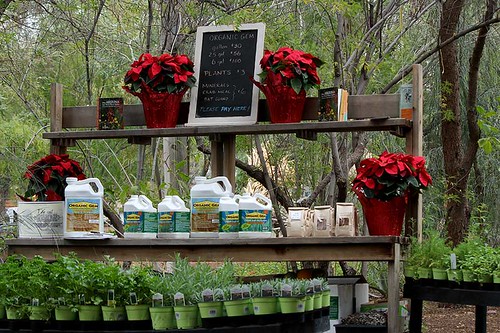 |
| Happy peppers at Singh Farm, 2015 |
 |
| Ken Singh, working his magic at Singh Farm with huge compost mounds in background. |
Earlier this month in the Master Gardener program we learned about the soil-food web and it brought back memories of spending time with the guru of soil-building, Ken Singh, at his oasis in the desert - Singh Farm. In less than 10 years Mr. Singh transformed a bare plot of reservation land into an absolute Garden of Eden by building the soil up naturally. I wanted to do the same in my own backyard so back in 2016 I asked Mr. Singh about picking up a truckload of his dirt. He immediately corrected me, with his big bearded smile he said "Peggy, it's SOIL not DIRT! Dirt is dead, soil is ALIVE!". I never forgot those words, and I did move a few truckloads of his amazing living soil to my yard. What a transformation it has made!
My garden in April 2016 just after the first few layers of Singh Farm SOIL -
My garden in April 2017 -
In class at the Master Gardener program we delved into N-P-K - Nitrogen, Phosphorous, Potassium, oh my! Those dubious three numbers that appear on all packages of fertilizer. What do they mean, and why should we care? It can all be very overwhelming. We should care about those numbers because Nitrogen promotes leaf growth, Phosphorus promotes fruit and bloom growth and Potassium promotes stem growth and overall plant health. Each number represents the percentage of that element in the fertilizer. So for example, in newly planted gardens you initially need nitrogen and potassium to develop big healthy leaves and strong stems so you would look for fertilizers with N-P-K 10-2-8 or 10-10-10. Then later as plants start to develop flowers (which leads to fruit) you want plant energy going into the fruit so an N-P-K of 2-10-6 is needed. ( FYI - The N-P-K percentages don’t equal 100 percent because there are other nutrients and filler product in fertilizer mixtures. This filler helps to apply the nutrients evenly over an area. )
This is all fine and dandy but do we really want to add all of these salt-rich commercial fertilizers to our already alkaline desert soils? NO. When all is said and done, the best solution for our alkaline clay-textured soils is to build our own healthy living soils. How? Simply put - compost, compost, compost, mulch, mulch, mulch, and deep water to flush away salts! A great example of what can happen when you build up a living soil is Jay Barringer's Edible Food Forest in Mesa, AZ. On just 1/8th of an acre Jay has over 300 edible fruit trees and vines, producing lush crops of mangoes, apples, peaches, plums, passion fruit, grapes, you name it and Jay has got it! You can see this incredible food forest this Saturday, February 24th from 9am to 11am.
Garden Tour & Fruit Tree Workshop w/ Jake Mace & Jay Barringer Saturday, February 24 at 9 AM - 11 AM Jay Barringer's Home is incredible. Only 1/8 of an acre of plantable land yet there are over 300 fruit trees and other gardens. This is a must see gardening event! In this tour and class Jake Mace and Jay Barringer will lead everyone through fruit trees, raised bed and in-ground gardens, where to get compost, how to make the best soil, wood chips, and the best edible trees to grow in the Phoenix area heat/cold! $30 per person. Location: 41 S 83rd Pl Mesa, AZ 85208
A great opportunity this weekend to see another style of soil-building called HugelKulture is at Agriscaping's Tour also on Saturday February 24th starting at 8am.
Agriscaping Edible Garden Tour Saturday Feb 24th at 8am in Gilbert - Tour Agriscape's Residential Research Facility and at 3 of their FAB 5 families' homes. Recent upgrades that you need to see include: Loads of new fruit trees, a new elegant Greenhouse and a new Hugelkulture in progress. Admission is $20 per person
 |
| Compost area at Singh Farm, Scottsdale, AZ |
Local sources for compost and mulch -
(These are small operations, call or message to make arrangements)
Jay Barringer - Phoenix Fruit Growers
GreenLife by Shamus O'Leary
Greg Peterson - The Urban Farm
Singh Farm - must call first to arrange for pick up,
Farm is no longer open to the public :-(
Singh Farm - must call first to arrange for pick up,
Farm is no longer open to the public :-(
When planting add in some Mycorrhizae (fungi). It is a critical link between the roots and the soil. Mycorrhizae allows nutrients to move into the plant and produces plant growth hormones.
Local sources for Mycorrhizae-
GreenLife by Shamus O'Leary
Longevity Garden - Jake Mace
www.getchipdrop.comHold the moisture into your living soil by adding thick layers of wood chips. Contact a local tree trimmer and ask for a "clean load" of wood chips. They will be happy to drop off a truckload for free, it saves them from paying to unload it at the city dump. Or you can sign up for ChipDrop - then arborists in the field can quickly look at a map on their phone to find dump spots for their chips. By filling out a simple form, you can add your home to the map, which all the tree companies in your city can see.












